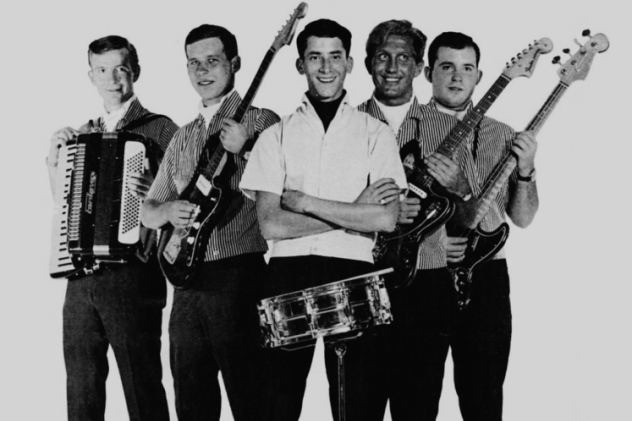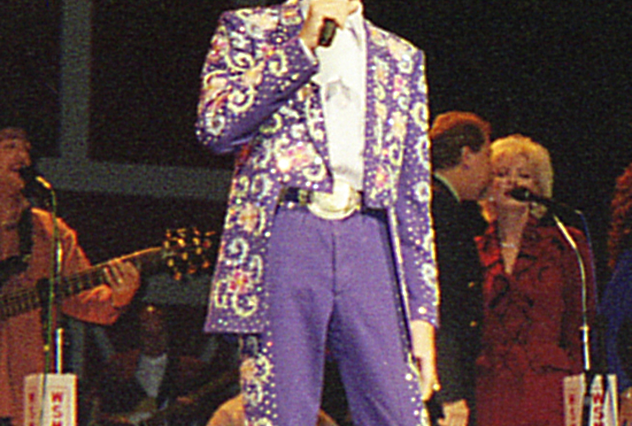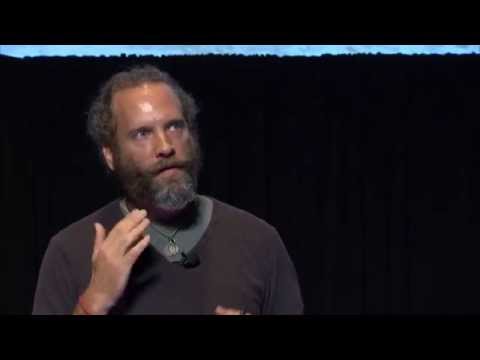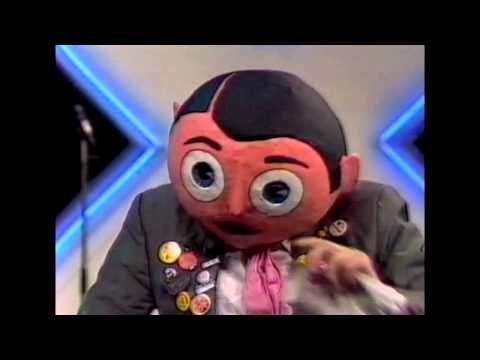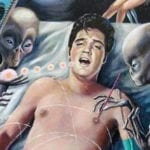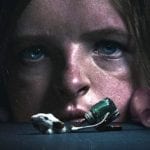10 Gary Lewis And The Playboys
Everybody knows Jerry Lewis—comedian, philanthropist, failed restaurateur, and Holocaust clown. Fewer people know about Jerry’s son, Gary, a young man who turned his back on comedy in exchange for a drum set and a pair of Beatle boots. Born in 1946, Gary’s musical career took off in 1964 after the Fab Four took the United States by storm. Like every young American male who knew—or didn’t know—how to play an instrument, Gary started his own band, a Beatles knockoff known as Gary and the Playboys. However, unlike most teenage bands, Gary’s group actually found a fair amount of success entertaining crowds at Disneyland, a feat that’s even more impressive when you realize that Gary was keeping his family history a secret. Even his dad didn’t know that he was playing gigs at the happiest place on Earth. Gary’s musical career was such a secret that his mom, Patti, promised to pay for a recording session so long as Jerry didn’t find out. Of course, you can only keep a secret from America’s favorite comedian (at the time) for so long, especially when your band churns out a hit song. Titled “The Diamond Ring,” Gary’s pop ballad made it onto Billboard’s top ten, and in 1965, CashBox magazine declared Gary the “Male Vocalist of the Year.” With “The Diamond Ring” playing on radios around the country, Gary was forced to confess his secret life to his father. According to actor/writer Eddie Dezeen, Jerry was ecstatic with his son’s success . . . just so long as he didn’t “grow [his] hair out like those damn Beatles!” During the Playboys’ heyday, Gary and his group appeared on The Ed Sullivan Show twice, toured with Dick Clark, earned eight gold singles, and sold 45 million records, which isn’t too shabby. Sadly, Gary’s musical career went on temporary hiatus after he was drafted, sent to Vietnam, and returned with a heroin problem. Fortunately, Gary was able to kick the proverbial monkey off his back and get back to his music, although he wasn’t quite as popular in a post-Woodstock world. It should also be noted there’s a bit of controversy surrounding Gary’s success. According to the Playboys’ producer Snuff Garrett, Gary’s albums were actually the work of studio musicians, and the band lip-synced during their first Ed Sullivan appearance. Needless to say, Gary vehemently denies these claims. So, who’s telling the truth? Well, let’s give Gary the benefit of the doubt. After all, the man is still performing to this day, so if you want to buy tickets, here’s his schedule.
9 Favio Chavez And The Recycled Orchestra
Life is tough in the town of Cateura. This Paraguayan village sits on the outskirts of Asuncion, the country’s capital city, and many of the town’s inhabitants earn their meager living working in the town’s massive landfill. Every day, gancheros (“recyclers”) trudge through the garbage, picking through pieces of junk and trying to find items they can recycle. While they forage through the Paraguayan garbage, their kids play amid the mountains of filth. At least, that’s what they did until Favio Chavez showed up. In 2006, Chavez was an ecological technician helping gancheros learn how to classify recyclable items. He also led a youth orchestra in his hometown, and one day, he brought the symphony out to Cateura so they could perform for his coworkers. Not only were the gancheros impressed, they wanted Favio to start an orchestra for their own kids. Favio agreed, but he hit a snag pretty quickly: There weren’t enough instruments to go around. At first, Favio loaned out his own instruments, but as more kids took an interest, he quickly ran out. The obvious solution would’ve been to buy more instruments, right? Actually, that would have posed a rather awkward problem. Real instruments are pretty pricey and worth their weight in gold to the average ganchero. If he gave a violin to a struggling kid, that might cause some family drama, so Favio decided to get creative. After teaming up with a carpenter named Nicolas Gomez, Favio started fashioning instruments out of junk lying around the landfill. It took quite a bit of experimentation to find which garbage worked the best, but after a lot of trial and error, they found the perfect combination of materials. For example, Chavez and Gomez created cellos out of oil barrels and violins out of forks and oven trays. Not only did the instruments sound amazing, but the kids also became proficient at playing rather quickly. Using their improvised instruments, the so-called Recycled Orchestra has performed around the world. The kids have entertained audiences in countries from Canada to Palestine to Japan. Favio and his talented team were also the subjects of a 2015 documentary called Landfill Harmonic. In addition to teaching music, Favio has become something of a South American John Keating. He believes that learning to play an instrument can teach kids determination, that picking up a violin can help them dream big and chase their goals, especially ones that lead them out of Cateura. Most importantly, the Recycled Orchestra can give them stability and hope in a world that’s full of so much garbage.
8 Jane FromanThe Stuttering Singer
Like so many stars of yesteryear, Susan Hayward has been largely forgotten by the moviegoing public. While most people wouldn’t recognize Ms. Hayward today, she was actually nominated for five Academy Awards, including a Best Actress Oscar for her performance in With a Song in My Heart, a 1952 biopic about Jane Froman, one of World War II’s most popular entertainers. Of course, Jane Froman’s life was a little different from the inspirational story that 1940s audiences saw on the silver screen. First, most of Froman’s fans had never heard her real voice, at least not her speaking voice. Jane had a major stuttering problem, so when NBC signed her to sing on air, radio executives came up with a tricky way to hide her speech impediment. After Jane finished entertaining audiences with her operatic voice, an actress would step up to the microphone and chat with the host or shill for sponsors, all while pretending to be Jane Froman. Radio fans never knew the difference, so when Susan Hayward played Jane in the 1952 film, nobody was upset when the filmmakers dropped the real-life stuttering subplot. Jane was voted New York’s most popular singer, joined the Ziegfeld Follies, and even tried acting, although her speech impediment killed that pretty quickly. Jane’s story takes an amazing turn after World War II: According to Nate DiMeo of The Memory Palace, Froman was the first star to offer her talents to the war effort. She’d fill the airwaves with patriotic ballads and entertain the boys at home and overseas. When she flew to Europe in 1943, her plane crashed into a Portuguese river, killing 24 of the 39 passengers aboard. Fortunately for Jane, the pilot made an impromptu raft out of smashed-up plane parts and helped the singer make it to shore. While she survived, her right arm was smashed, her left leg was sliced to pieces, and doctors wanted to amputate her right leg. Unwilling to lose a limb, Froman refused the operation, but she battled infections and pain for the rest of her life. Impressed by her bravery, President Roosevelt made sure that Jane had access to penicillin (most of which was saved for soldiers). Before she passed away in 1980, she’d undergo a grand total of 37 surgeries. She also wore a permanent leg brace and eventually found herself addicted to her medication, but Jane never let pain get in her way. After the crash, she gave 95 shows for US troops. In fact, during those first few performances, she hobbled out on stage with a pair of crutches. When the war finally came to an end, Froman provided the vocals for the Susan Hayward biopic, starred on a CBS TV show, and earned a gold record for her hit song “I Believe.” Whenever she stepped in front of an audience, she always wore dresses designed to hide her battle wounds.
7 Glen WeyantPlaying The Border Wall
If you were to draw up a list of the least musical places on Earth, you might suggest a Palestinian refugee camp, downtown Mogadishu, or a North Korean prison cell. These places do not cause the heart to sing with joy. Right up there alongside Japan’s Suicide Forest and the ruins of Chernobyl, there’s the Mexican-American border, a nasty strip of desert plagued with cartel violence and spotted with unidentified bodies—corpses of people who were just searching for a better life. Symbolizing all of that pain and suffering is the US-Mexico border wall, a series of fences that separate the two North American countries. This place is about as soul-crushing as it gets, but once a month near the town of Sasabe, Arizona, a man named Glen Weyant drives out to the wall, unpacks his bag of musical equipment, and creates a incredibly crazy symphony . . . using the wall as his primary instrument. According to Vice, Weyant’s wall is “a massive metal structure made of 20-foot-high steel beams, a few inches apart, rusted the color of dried blood.” But what looks imposing to most of us appears almost lyrical to Mr. Weyant. He rubs the beams with a wire drum brush, reaches through the gaps and beats the Mexican dirt with a rubber mallet, and “plays” the fence with an assortment of violin and cello bows. Sometimes he’ll improvise with nearby sticks. Other times, he’ll experiment on the nearby watchtower or water bottles left behind by thirsty immigrants. And if he’s feeling really weird, perhaps he’ll blow through a moose call or even wear a goat mask. Glenn records every note with contact microphones, devices that amplify the sound of his cacophonous creations. Since he performs next to a camera, when he finishes his insane symphony, Weyant files a Freedom of Information Act request, asking the government to hand over the audio and video recordings of his crazy compositions. So what motivates this man to drive out to this wall and beat on the beams? (It is perfectly legal to do so, by the way.) Glenn sees the fence as a “symbol of fear and loathing,” and he wants “to transform it into something else . . . an instrument so that people on both sides can have open dialogue and communication.” Glenn wants musicians from both sides of the border to meet up and work their magic on the border wall. By turning the fence into a gigantic instrument, Glenn believes he can “demolish its concept, remove it as a wall.” Once it’s gone, that great, big, country-separating fence will become an even bigger bridge, musically speaking.
6 Nudie CohnThe Man Who Made The Rhinestone Cowboy
Unlike most of the folks on this list, Nudie Cohn wasn’t a musician. He never performed on stage or cut an album, and for all we know, he never even learned to play an instrument. But while he wasn’t a singer or guitarist, Cohn was one of the most influential figures in the country music scene. Contrary to his unusual name, Nudie was famous for making clothes, the kind that popped with intricate patterns and sparkled with big, gaudy rhinestones. Born in turn-of-the-century Ukraine, Nudie’s real name was Nuta Kotlyarenko. When Nuta was 11 years old, his parents sent him to the US, hoping he could avoid the anti-Semitism sweeping their homeland. When Nuta arrived at Ellis Island, an immigration official shortened his last name to Cohn and screwed up his first, writing “Nudie” instead of “Nuta.” The name stuck, and as Nudie grew older, he earned a living with a skill he’d learned in the old country—sewing and fitting clothes. In the 1940s, Nudie opened a store in Hollywood that attracted some pretty big names like Roy Rogers and Dale Evans, the crooning cowboy couple. Nudie hit the big time after designing an outfit for honky-tonk singer Lefty Frizzell. On the back, Nudie wrote Lefty’s initials with blue rhinestones, and the rest of the country community was awestruck. Soon, stars were calling up Cohn, asking for their own specialized “Nudie suits.” Over the years, he designed outfits, some more flamboyant than others, for the likes of George Jones, Marty Robbins, Johnny Cash, and Hank Williams. He even attracted the attention of pop singers like Cher and rockers like John Lennon. And it goes without saying that one of Nudie’s most famous clients was the “Rhinestone Cowboy” himself, Glen Campbell. These Nudie suits were emblazoned with wagon wheels, lightning bolts, and UFOs (that one belonged to Keith Richards). Of course, each suit came with enough bling to blind anyone standing too close. Perhaps Nudie’s most famous outfits were designed for Gram Parsons and Elvis Presley. Gram’s outfit was decked out with marijuana plants, poppy flowers, pills, a naked woman, and a big, red cross. As for Elvis, Nudie created the iconic $10,000 gold lame tuxedo that the King sported on the cover of 50,000,000 Elvis Fans Can’t Be Wrong. In addition to clothing, Nudie loved to pimp out Cadillacs and Pontiacs. These insane automobiles came equipped with Longhorn horns on the hood, Colt pistols for door grips, and saddles instead of child seats. Everything Nudie touched was wild, garish, and completely over-the-top. That’s why as long as country music exists, we’ll always remember his outlandish suits. Interestingly, Nudie’s son-in-law, Manuel Cuevas, designed the Beatles’ marching band suits for Sgt. Pepper’s Lonely Hearts Club Band.
5 Amber Galloway GallegoThe Musical Sign Language Star
It’s safe to say that most people associate music with hearing. Our ears are kind of essential to the whole musical experience, or at least that’s what non-deaf people think. In truth, hearing-impaired people enjoy a good song just like the rest of us, and thanks to the Americans with Disabilities Act, US concert venues must provide interpreters upon request. One of the best interpreters in the business is Amber Galloway Gallego, a woman who takes sign language to whole new level. Born in Texas, Gallego knew several deaf people growing up and was inspired to study American Sign Language in college. After graduation, Gallego dedicated herself to making music enjoyable for the hearing-impaired. According to the Texan, most musical interpreters are kind of full of it. They might sign all the words, but they’re not actually expressing what the artist wants to say. They lack any real emotion or passion, so they can’t convey the singer’s actual meaning. That’s not the case with Amber Gallego, not by a long shot. Whenever Gallego interprets for a crowd, she incorporates a whole host of “non-manual” signs. She uses body language and facial expressions and bases her performance on the tone and message of each particular song. As Gallego puts it, when she’s on the stage, the audience is going to “see the spirit of the artist.” Gallego has signed for quite a few celebrities. Working at concerts like Lollapalooza and SXSW, she’s interpreted for the likes of Snoop Dog, Eminem, The Rolling Stones, The Black Keys, Cher and Madonna. That’s a pretty impressive lineup. Of course, Gallego’s job isn’t exactly easy. Usually, performers neglect to send her a list of what songs they’re going to sing, so she has to memorize pretty much their entire oeuvre. In addition to memorizing lyrics, she reads bios of the entertainers to get a feel for them as people and watches videos of their performances to get a feel for them as artists, so she can properly “channel” the singer’s personality for her audience. Depending on where she’s working, Gallego sometime has to learn regional slang words to incorporate into her routine, but perhaps the biggest challenge is interpreting words made up by the artist or figuring out how to convey metaphorical ideas. For example, if a male singer were to mention his . . . “anaconda,” she would give the literal sign for “snake,” but she also has to move her arm in such a way that indicates, well, you know. For all her hard work, Gallego only earns about $500 per show, but it’s not about the money for her. It’s about sharing music with the world, one hand gesture at a time.
4 Brian Gorman And Marcus StoeszThe Real Life School Of Rock
If you’re a fan of rock music, movies, or plain old fun, then you’ve probably heard of School of Rock. Richard Linklater’s lighthearted comedy follows a schlubby slacker (played by Jack Black) who teaches an elementary class how to rock out. Of course, School of Rock is just a movie, pure fiction cooked up by screenwriter Mike White, but Rock Band Land is a very real place indeed. Founded by musicians Brian Gorman and Marcus Stoesz, Rock Band Land is a San Francisco school where kids aged four to 12 learn to unleash their inner Johnny Rotten. Gorman was inspired to open this punk preschool after getting sick with “saccharine” kiddie songs. You see, when Gorman wasn’t playing drums with his own band, he was teaching two- and three-year-olds and working with children, meaning that he was exposed to a lot of “condescending, insulting, gross” music. Wanting to shake up the preschool musical landscape, Gorman, along with Stoesz, launched Rock Band Land with the hopes of teaching kids to write awesome songs and to work as a team. Sessions start on Monday with the children wandering into the “rock out room” to pick up their instruments and start riffing, accompanying each other in impromptu rock sessions. When the kids find a melody or rhythm that sounds pretty cool (and they can easily repeat), Stoesz incorporates their work into an actual song. After the kids are done jamming, Gorman helps the kids write the lyrics. Everyone is encouraged to contribute ideas, as long as they’re original, and while songs can get scary, they need to have a positive ending. Perhaps most importantly, no one is allowed to say “no.” If someone doesn’t like a story suggestion (all Rock Band Land songs tell a story), they’re required to create a solution, a way to make the idea work for everyone. According to Rosie Cima of Priceonomics, “If Gorman can tell one of the kids is uncomfortable with a vampire in a story, for example, he’ll help them adapt it. [. . .] ‘This vampire doesn’t drink blood! What does this vampire drink instead?” After the lyrics and music are finished (and attached to a catchy title like “The Cockroach’s Revenge”), the kids spend the rest of the week rehearsing and recording. When Friday finally rolls around, the kids take to the stage to perform for their expectant parents. Rock Band Land is about a lot more than playing awesome tunes and liberating people with music. It’s about creativity, collaboration . . . and sticking it to the man.
3 Papo La BalaThe Rocker Who Injected Himself With HIV
This probably won’t come as much of a shock, but communist Cuba wasn’t really the best place to be a punk rocker. Rebellious teens, known as los frikis (“the freaks”), used their radios to pick up American airwaves and rock out to groups like AC/DC and Metallica. However, getting the Led out came with a pretty steep price. Kids sporting long hair, ripped jeans, and T-shirts emblazoned with rock band logos were regularly assaulted by the police. When scruffy teens showed up for school, they were often surrounded and forcibly shaved. Anyone caught listening to rock music was tossed behind bars or sent to work in the sugarcane fields. The Berlin Wall had just collapsed, the USSR was falling apart, and Fidel Castro was freaking out. Hoping to keep his regime intact, the bearded director went after anyone who stepped out of line, cracking down hard on rock music and angrily shouting, “Socialism or death!” That’s when one musician accepted the challenge. His name was Papo la Bala (“Papo the Bullet”), and today, he’s known as the “Kurt Cobain of the Frikis.” This Cuban rock star grew up in poverty, and by the time his 14th birthday had rolled around, Papo was living in the streets. His dear old dad was a drunkard, his mom took off when he was just a kid, and he was living in one of the toughest dictatorships on the globe. It was the perfect recipe for cooking up the quintessential punk rocker. Wearing the American flag like a star-spangled bandanna, Papo waged war against the state with the power of music. He wasn’t content fighting Castro’s government with his six-string alone. Papo the Bullet wanted to make a bigger, and deadlier, point. That’s why he met up with a few rocker friends who’d contracted HIV and injected himself with their infected blood. If it was “socialism or death,” then Papo was choosing the latter because, as he explained to a friend, “When you don’t have any more doors to open, death is a door.” As you might guess, Papo’s last days weren’t pleasant, but in spite of the disease that ended his life, Papo didn’t regret his decision. Even though he converted to Christianity—which perhaps was the ultimate act of rebellion in atheistic Cuba—he never lost his punk rock persona, defying Castro to the very end. Unfortunately, Papo inadvertently launched a movement. Hundreds of teens who didn’t really understand AIDS followed his example, figuring that the government would eventually find a cure, and they’d all be fine. Sadly, they were wrong.
2 Jason EvermanThe Rock Star Who Became A Soldier
Most musicians only dream of playing in a world-famous rock band. Jason Everman played in two, and was kicked out of both. However, after his musical career crashed and burned, Everman didn’t get depressed or wind up lost in the melancholy world of “what if.” Instead, he became one of the toughest dudes on planet Earth. Everman’s musical career, oddly enough, was kick-started after a trip to a therapist’s office. Jason’s mom was a depressive drug addict, and thanks to his troubled home life, Everman started acting out. After he blew up a toilet with an M-80 firecracker, his worried grandmother sent him to get professional help. As it turns out, the therapist had a couple of vintage guitars lying around the office, and after picking one up, Jason couldn’t put it down. A few years later, a drummer friend of Jason’s—a guy by the name of Chad Channing—told Everman that his band was looking for a new guitarist and offered him the spot. Everman said yes, and soon, he was touring with a little rock band called Nirvana. At first, things went relatively well, and Jason even paid the $600 the band owed for cutting their first album, Bleach. But as the group drove across the US, the rest of the band grew a little miffed with the new guitarist. He often slipped into strange funks and just cut everyone off, which made all those hours on the road painfully awkward. Soon, the band was fed up with the “moody metalhead” (Kurt Cobain’s words) and fired him from the band, right before the group hit superstardom. That didn’t matter to Jason because right after leaving Nirvana, he was hired to play bass for Soundgarden. Although he was a skilled musician, the Soundgarden guys didn’t care for his introverted, angry attitude either, and Everman lost his second big-time gig, again before the band hit international celebrity status. Out of a job, Everman decided to mix things up by joining the Army. As Jason put it in a New York Times profile, joining the armed forces was “the most uncool thing you could possibly do,” but he wanted to give it a shot anyway. He also wanted to keep his rock star status a secret, but his brothers-in-arms always seemed to uncover his musical history. Luckily, aside from the occasional wisecracking sergeant, his past never really interfered with his new life. Eventually, Everman became an Army Ranger and was sent on at least one mission to Latin America. Wanting to take things even further, he joined the Special Forces, and after 9/11, he was sent to both Afghanistan and Iraq, where he took part in covert raids, narrowly avoided suicide bombers, and galloped alongside Pashtun warriors. After retiring from the military, Everman graduated from Columbia University with a degree in philosophy, and today, he spends his time writing. As for his missed musical opportunities, he’s not bothered. As one Daily Beast article put it, “He didn’t go into Special Forces and the Columbia philosophy department because he was trying to make up for a missed chance at being a rock star. He joined the Army because Nirvana and Soundgarden weren’t enough for him.”
1 Frank SidebottomThe Man Inside A Mask
Frank Sidebottom’s real name was Chris Sievey. He was a musician from Timperley, Greater Manchester, and whenever he put on the giant papier-mache head, he answered only to Frank Sidebottom. That’s right, we said “giant papier-mache head.” It was complete with two enormous, eerie blue eyes and a lipsticked mouth that never moved. What would possess a man to wear a homemade head while performing in front of a live, though tiny, audience? Creativity, eccentricity, and desperation. Frank’s (or Chris’s) story starts in 1970, when the 15-year-old hitchhiked to London and started a band called The Freshies. Unfortunately, no one was interested in signing his group, and the band eventually broke up. Undeterred, Chris kept on trying to make it in the music world. That’s when he invented Frank, a child-like character with a big, honking head, a character known for his innocence and “ordinariness,” qualities that strongly contrasted with Chris’s penchant for wine, women, and getting wasted. Whenever Chris slipped on the fake head, he completely disappeared into his papier-mache persona. He moved differently, spoke differently, and only responded to calls of “Frank.” According to his bandmate Jon Ronson (of The Men Who Stare at Goats and The Psychopath Test fame), Chris would keep the Frank head on for hours, even when driving from gig to gig. Sometimes, Chris would even mail letters to Frank . . . and then Frank would write back. Naturally, all of this nuttiness carried over to the stage. Whenever Frank and his Oh Blimey Big Band showed up at a club, their shows were unconventional, to say the least. Frank and his crew never rehearsed before a show. Whenever they took the stage, the band simply followed Frank’s lead, whether it was performing quirky covers of “We Are the Champions” or singing parodies like “Born in Timperley” (“Born in the U.S.A.”). And the audience (well, the few people who showed up) absolutely loved it. In addition to performing in clubs, Frank also showed up on late night TV and early morning kids’ shows. In 1992, he even appeared on his very own TV show, Frank Sidebottom’s Fantastic Shed Show. As time went on, Chris eventually put the head away and got into the animation game, working on shows like Pingu and Bob the Builder. While his alter ego made a brief comeback in the mid-2000s, Chris and Frank passed away in 2010. However, Frank’s reputation lives on to this day in the form of a documentary, a fictionalized biopic starring Michael Fassbender, and a big-eyed bronze statue in his hometown of Timperley. Nolan Moore knows he can’t really sing, but when he’s driving, showering, or playing Beatles Rock Band, well, he just doesn’t care. If you want, you can friend/follow Nolan on Facebook, or you can send him an e-mail.
